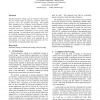Free Online Productivity Tools
i2Speak
i2Symbol
i2OCR
iTex2Img
iWeb2Print
iWeb2Shot
i2Type
iPdf2Split
iPdf2Merge
i2Bopomofo
i2Arabic
i2Style
i2Image
i2PDF
iLatex2Rtf
Sci2ools
SEW
2006
IEEE
2006
IEEE
Pseudo-Exhaustive Testing for Software
Pseudo-exhaustive testing uses the empirical observation that, for broad classes of software, a fault is likely triggered by only a few variables interacting. The method takes advantage of two relatively recent advances in software engineering: algorithms for efficiently generating covering arrays to represent software interaction test suites, and automated generation of test oracles using model checking. An experiment with a module of the Traffic Collision Avoidance System (TCAS) illustrates the approach testing pairwise through 6-way interactions. We also outline current and future work applying the test methodology to a large real-world application, the Personal Identity Verification (PIV) smart card. Keywords automated testing, combinatorial testing, software testing
Keywords Automated Testing | SEW 2006 | Software Interaction Test | Traffic Collision Avoidance System |
| Added | 12 Jun 2010 |
| Updated | 12 Jun 2010 |
| Type | Conference |
| Year | 2006 |
| Where | SEW |
| Authors | D. Richard Kuhn, Vadim Okun |
Comments (0)

